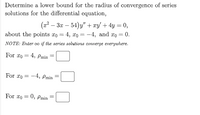
Advanced Engineering Mathematics
10th Edition
ISBN: 9780470458365
Author: Erwin Kreyszig
Publisher: Wiley, John & Sons, Incorporated
expand_more
expand_more
format_list_bulleted
Question

Transcribed Image Text:Determine a lower bound for the radius of convergence of series
solutions for the differential equation,
(22 – 30 – 54)y" + xy' + 4y = 0,
%3D
about the points xo = 4, x = -4, and xo = 0.
NOTE: Enter o if the series solutions converge everywhere.
For co
4, Pmin
%3D
For xo = -4, Pmin
%3D
For xo = 0, Pmin
Expert Solution
arrow_forward
Step 1
Given:
The differential equation
To find:
Lower bound for the radius of convergence , of series solutions for the given differential equation about
Trending nowThis is a popular solution!
Step by stepSolved in 4 steps

Knowledge Booster
Similar questions
- Consider the differential equation x^2y" + x (1−x)y' − xy = 0. a. Show that X0=0 is a regular singular point. b. Determine the indicial equation, the recurrence relation, and the roots of the indicial equation. c. Find the series solution for x>0 corresponding to the larger root. d. Find the series solution corresponding to the smaller root by following the procedure outlined in section 5.4 and demonstrated in section 5.7.arrow_forwardI need the next 3 parts pls!arrow_forwardConsider the following differential equation to be solved using a power series. y'' + xy = 0 Using the substitution y = ∞ cnxn n = 0 , find an expression for ck + 2 in terms of ck − 1 for k = 1, 2, 3 . ck + 2 = Ck−1(k+2)(k+1)arrow_forward
- Find the first four nonzero terms in a power series expansion about x = 0 for a general solution to the given differential equation. (x² +21)y"+y=0 y(x) =+ (Type an expression in terms of a and a, that includes all terms up to order 3.)arrow_forwardThe point x = O is a regular singular point of the given differential equation. Find the recursive relation for the series solution of the DE below. Show the substitution and all the steps to obtain the recursive relation. Do not solve the equation for y=y(x) xy" + 4y' - xy = 0, 1 a. Ck+1= (k+r+ 1)(k+r+3) 1 b. Ck+1 = (k+r+1)(k+r+4) ·Ck-1, k≥ 1 с. Ск d. Ck² e. Ck O a P = e 11 || 1 k+r I k+r ·Ck-1, k≥1 -Ck-1, k≥1 -Ck-1, k≥1 (k+r)² +5(k+r) 1 (k+r)²-2(k+r) -8 ·CK-2, k≥2arrow_forwardTry to use the method of Frobenius to find a series expansion about the irregular singular point x = 0 for a solution to the given differential equation. If the method works, give the first four nonzero terms in the expansion. If the method does not work, explain what went wrong. 3x²y+3y' - 6y=0arrow_forward
arrow_back_ios
arrow_forward_ios
Recommended textbooks for you
 Advanced Engineering MathematicsAdvanced MathISBN:9780470458365Author:Erwin KreyszigPublisher:Wiley, John & Sons, Incorporated
Advanced Engineering MathematicsAdvanced MathISBN:9780470458365Author:Erwin KreyszigPublisher:Wiley, John & Sons, Incorporated Numerical Methods for EngineersAdvanced MathISBN:9780073397924Author:Steven C. Chapra Dr., Raymond P. CanalePublisher:McGraw-Hill Education
Numerical Methods for EngineersAdvanced MathISBN:9780073397924Author:Steven C. Chapra Dr., Raymond P. CanalePublisher:McGraw-Hill Education Introductory Mathematics for Engineering Applicat...Advanced MathISBN:9781118141809Author:Nathan KlingbeilPublisher:WILEY
Introductory Mathematics for Engineering Applicat...Advanced MathISBN:9781118141809Author:Nathan KlingbeilPublisher:WILEY Mathematics For Machine TechnologyAdvanced MathISBN:9781337798310Author:Peterson, John.Publisher:Cengage Learning,
Mathematics For Machine TechnologyAdvanced MathISBN:9781337798310Author:Peterson, John.Publisher:Cengage Learning,


Advanced Engineering Mathematics
Advanced Math
ISBN:9780470458365
Author:Erwin Kreyszig
Publisher:Wiley, John & Sons, Incorporated

Numerical Methods for Engineers
Advanced Math
ISBN:9780073397924
Author:Steven C. Chapra Dr., Raymond P. Canale
Publisher:McGraw-Hill Education

Introductory Mathematics for Engineering Applicat...
Advanced Math
ISBN:9781118141809
Author:Nathan Klingbeil
Publisher:WILEY

Mathematics For Machine Technology
Advanced Math
ISBN:9781337798310
Author:Peterson, John.
Publisher:Cengage Learning,

